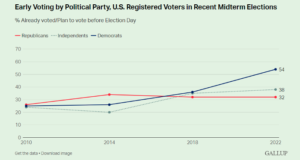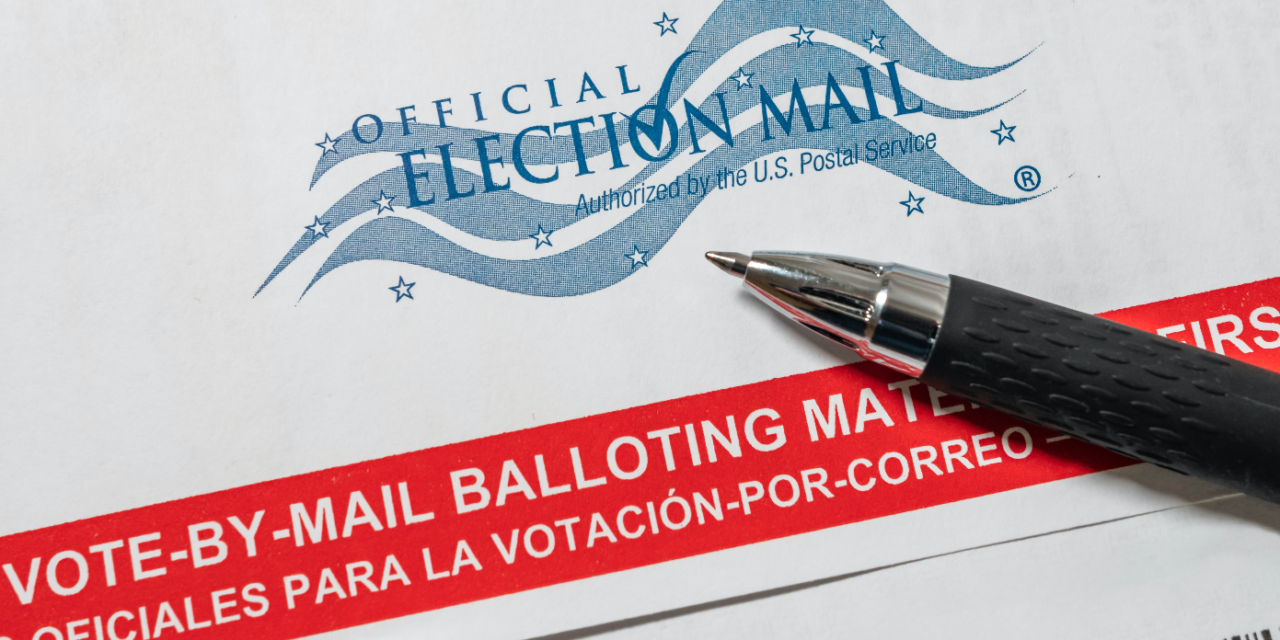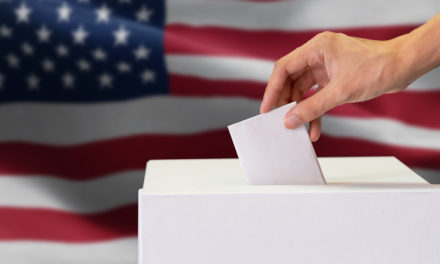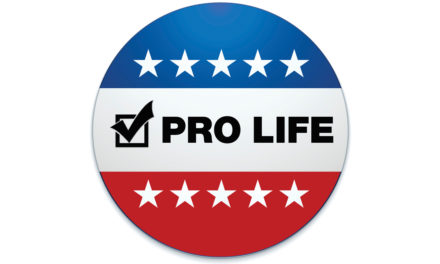Midterm elections (i.e., non-presidential voting years) typically do not generate as much voter interest compared to presidential election years. But they’re also not the disappointments they once were. The midterm elections in 2018, for example, had the highest voter turnout rate since 1914.
The 2022 midterms are shaping up to be even bigger, in terms of turnout, than 2018, according to election experts. More people are voting early, or sooner, than they have in past midterm elections.
Why is that, and what does it all mean for the ultimate results on November 8?
The United States Elections Project, which keeps track of such things, reports that as of November 2, more than 28 million Americans have already voted in the 46 states (plus the District of Columbia) for which information was available. Four states (Alabama, Connecticut, Mississippi and Nevada) do not offer early voting, except for absentee ballots.
In the 23 states where political party affiliation is included with the early voting data, the breakdown looks like this: 44.7% Democratic, 33.3% Republican, and 22% None/Other.
Historically, Democrats and Republicans cast early votes in relatively similar percentages, but that may be changing for the 2022 midterms, according to a new Gallup poll taken October 3-20. According to Gallup, more Democrats (54%) than Republicans (32%) say they will vote early, with 38% of independents reporting they will do so. That increasing disparity, U.S. News and World Report speculates, may simply be due to different preferences on how to vote, as well as conservatives’ concern over election integrity and the results of the 2020 presidential election.

Overall, the high turnout in 2022 can be partly attributed to controversial issues and high-profile races, of course, but there are other factors at play in the high numbers this year.
A large reason for the increase in early voting this year, according to Michael McDonald, the University of Florida professor who oversees the Elections Project, is that many state legislatures have expanded mail-in and early voting options recently, primarily due to COVID-19 concerns ahead of the 2020 elections.
“What we’re observing here is that some people have changed their behavior,” McDonald told ABC News. “They’re either voting early, where they may not have done so in a past midterm election, or they’re voting sooner than they would have,” he said. “Those are both things that we saw in 2020, where people were not only voting by mail, and in person early at greater frequencies than they had past elections, but they were also voting earlier than they had in prior presidential elections.”
Not unexpectedly, the large, populated states lead the pack of early voters, with nearly 4 million votes already cast in Texas, 3.3 million in Florida, and 3 million in California. If you’re interested in early vote totals in any particular state, Elections Project has links to the various reporting states here.
With control of the U.S. Senate and House a key issue in the midterms, races in battleground states such as Pennsylvania and Arizona are also driving early voting there.
In Pennsylvania, where Dr. Mehmet Oz and John Fetterman are locked in a hotly contested race for U.S. senator, registered Democrats have cast 70.9% of the early votes, as compared to 20.5% of Republicans.
In Arizona, where tight races include Sen. Mark Kelly vs. Blake Masters for the U.S. Senate and Kari Lake vs. Katie Hobbs for governor, Democrats have only slightly outpaced Republicans in early voting, 39.6% to 37%.
Another state to watch is Georgia, where Secretary of State Brad Raffensperger announced record breaking turnout in early voting this year after problems that occurred during the 2020 election resulted in election reforms passed by the state legislature.
Left-leaning politicians are hoping that reaction to the U.S. Supreme Court’s decision in Dobbs v. Jackson Women’s Health Organization will drive more pro-abortion voters to the polls, especially in places like Colorado, a blue state with permissive abortion laws.
However, in Colorado’s conservative El Paso County, which includes Colorado Springs and a large military community, the County Clerk and Recorder reports that he has seen a 7% over performance by Republican registered voters in early voting and a 7% underperformance by Democrats thus far as compared to previous years. Statewide, however, early voting in Colorado breaks down as 33.1% Democrat, 29.2% Republican, and 37.7% None/Other.
And five states – California, Kentucky, Michigan, Montana and Vermont – have abortion-related ballot initiatives likely to generate a lot of voter interest. At this point, though, we don’t have any data on how much those issues are impacting early voting.
Nationally, however, younger voters, who tend to skew more pro-abortion than older voters, make up a smaller share of early and absentee voters so far than they did in 2020, according to an analysis by Politico. If that trend continues for the remainder of midterm voting, it could spell good news for pro-life Americans.
2022 is shaping up to be an important midterm election year, and voters seem to understand that. As Christians, it is up to us to participate in our nation’s system of self-government at every opportunity.
Please vote your values on November 8.
The Daily Citizen has articles and information on the 2022 election available here.
Photo from Shutterstock.






